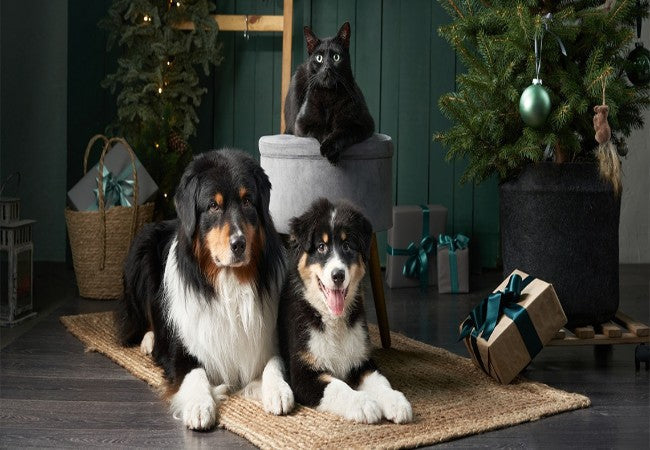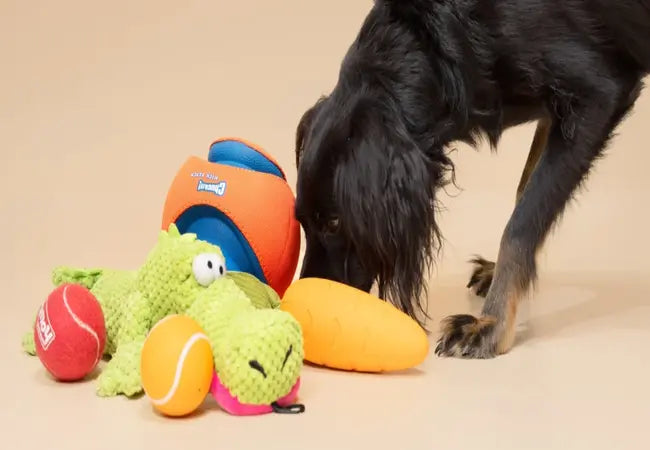In this article
🐶 Enrichment for Senior Dogs: Vet-Recommended Activities for 2025 Wellness 🧠
By Dr Duncan Houston, BVSc
As dogs age, they face physical and cognitive changes that may limit their activity—but that doesn't mean life has to slow to a halt. Enrichment is the key to keeping your senior dog mentally stimulated, emotionally fulfilled, and physically active in a way that’s safe and enjoyable. In this 2025 guide, we’ll explore enrichment strategies that help older dogs thrive. 🐾
🔍 What Is Enrichment?
Enrichment involves offering experiences and activities that encourage natural behaviors and support physical and emotional well-being. There are two main types:
- 🌿 Environmental Enrichment: Toys, puzzles, changes to surroundings
- 👨👩👧👦 Social Enrichment: Positive interactions with humans or other animals
Enrichment must be tailored to your dog’s individual needs and preferences—and always offered as a choice. If your dog doesn’t engage, that’s OK. Let them explore at their own pace. 🧠💛
🧓 Why Senior Dogs Need Enrichment
As dogs age, they can experience:
- 🐕 Arthritis and mobility issues
- 🦷 Dental disease
- 🧠 Canine Cognitive Dysfunction (similar to dementia)
- 🧪 Diabetes, endocrine, or liver conditions
These changes can lead to reduced movement, anxiety, and behavioral shifts. Enrichment supports:
- 📉 Anxiety reduction
- 🏃 Improved mobility and comfort
- 💞 Strengthened bonds with humans
- 🧠 Cognitive stimulation and confidence
🩺 Step One: Vet Check-In
Before starting enrichment activities, consult your vet to:
- 📋 Rule out medical issues contributing to behavior changes
- ⚖️ Evaluate weight and diet
- 🩹 Create a plan tailored to your dog’s condition
🎯 Enrichment Ideas for Senior Dogs
🚶♂️ Shorter Walks & Sniff Time
- 🌳 Even short walks are beneficial
- 👃 Focus on sniffing rather than distance
- 🧘 Let your dog set the pace—outdoor time matters!
🧩 Puzzle Feeders
- 🛒 Buy or DIY—use bottles, muffin tins, or cardboard tubes
- 🍽️ Use their regular kibble or mix in special treats
- ❄️ Try freezing meals for longer activity
🌼 Snuffle Mats
- 🐕 Great for foraging behaviors and cognitive stimulation
- 🌺 Choose safe scents: coconut, vanilla, valerian
- 🧴 Avoid unsafe essential oils: tea tree, peppermint, wintergreen
🔍 Scavenger Hunts
- 🍗 Hide food, toys, or treats around the house or yard
- 🛏️ Start by hiding items near familiar spots
- 🧠 Slowly increase difficulty for mental challenge
🎓 Positive Reinforcement Training
- 🐾 Yes, old dogs CAN learn new tricks!
- 🎉 Teach practical cues (sit, stay) or fun tricks (shake, speak)
- 🧠 Use clickers or verbal markers—no physical effort needed
🐕 Social Time with Calm Dogs
- 👯 Schedule playdates with senior or low-energy dogs
- 🧘 Monitor body language for signs of relaxation
- 🗣️ Keep interactions brief and positive
🧠 Create a Routine
Consistency helps senior dogs feel secure. Try adding:
- 🍽️ Regular meal times
- 🎾 Scheduled daily enrichment sessions
- 😴 Quiet periods for rest
- 🧩 New enrichment rotated weekly
✅ Safety Tips
- 🛏️ Avoid slippery floors—use rugs or mats
- 🪑 Watch for fatigue—stop if they seem tired or sore
- 🍗 Supervise with new toys to ensure they don’t chew unsafe parts
📝 Final Thoughts from Dr Duncan Houston
Enrichment isn’t just for puppies—it’s a vital part of senior dog care. By tailoring activities to your dog’s abilities and preferences, you can extend their joy, confidence, and quality of life. Whether it’s a sniff walk or a snuffle mat, the little moments make a big difference. 🐶🧠💛
Need help planning enrichment for your senior pup? Visit AskAVet.com or download the Ask A Vet app 📱 to connect with veterinary professionals who can guide your dog’s golden years with grace and play. 🛏️🐾






